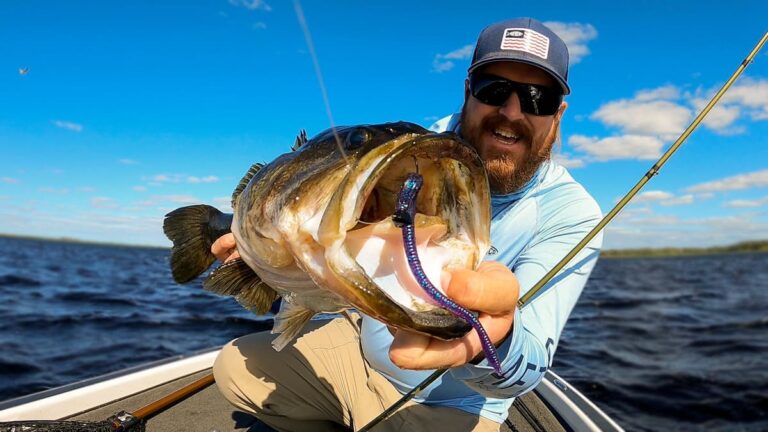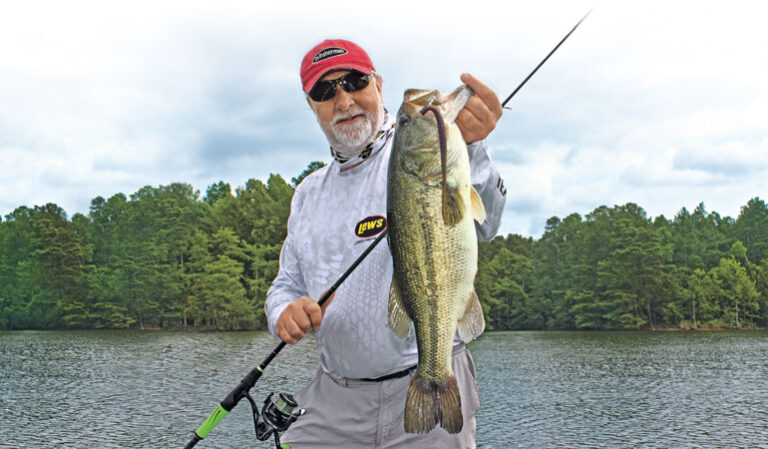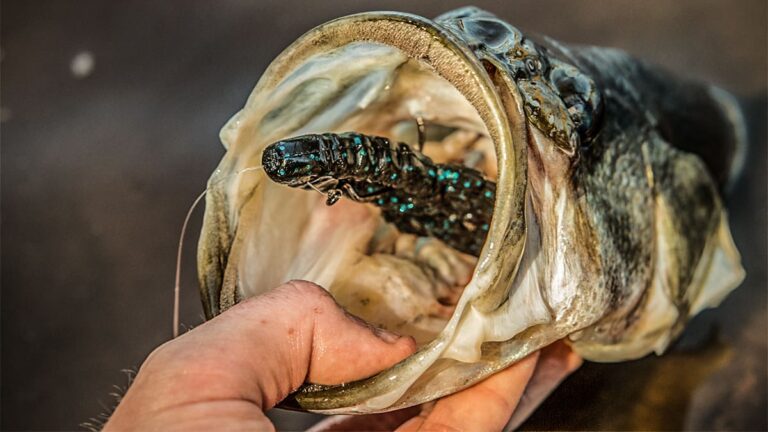Waking a Fluke: How and Why
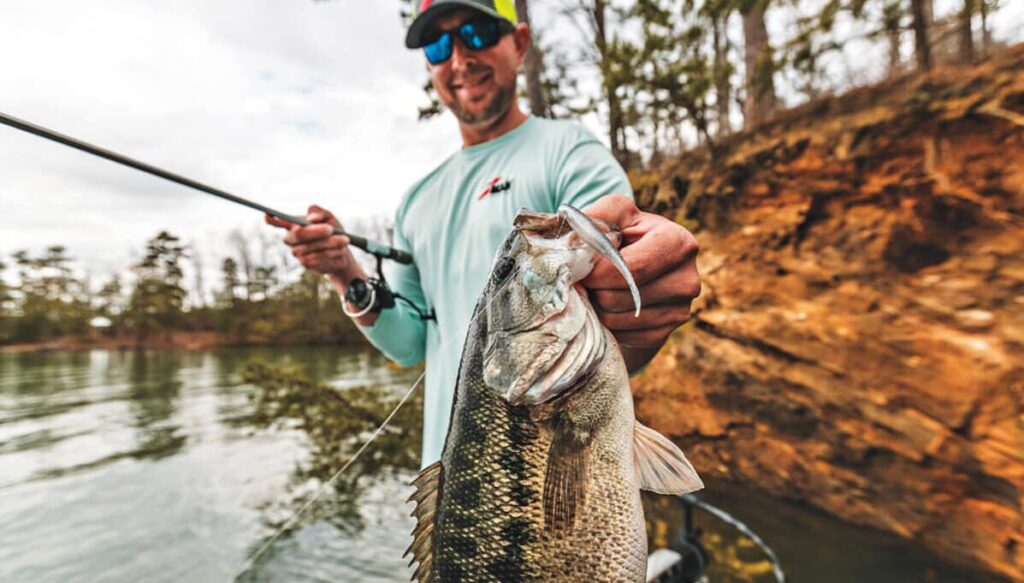
Fluke style soft plastic baits are some of the most realistic lure options in all of the fishing market.
There are tons and tons of rigging methods for them, and they are super realistic profiles.
And one technique has recently started catching serious traction. This is waking a fluke for bass fishing.
What is Waking a Fluke?
There are practically limitless ways to fish fluke style soft plastics.
In the last couple of years, waking a fluke has become one of my absolute favorite of those techniques.
Waking a fluke is exactly what it sounds like. You are reeling the fluke up on the surface and causing the bait to subtly move side to side.
This causes a wake on the surface that looks super natural and enticing to bass looking up from below.
The concept is similar to an actual wake bait, but is much more subtle, realistic, and finesse.
How to Make the Fluke Wake
This part is actually super easy because fluke style baits will naturally have a tendency to move back and forth.
But there still are a few things to keep in mind.
First, you want to choose a bit lighter weight hook than you would normally rig up on a fluke.
I’ll get more specific about that later in the article, but for now just keep it in mind.
Second, you want to start your retrieve as soon as the fluke its the water.
This way it doesn’t have time to sink down and is easier to keep on the surface.
And lastly, keep your rod tip up will reeling to keep the fluke on the surface.
With those in mind, all you have to do is slowly reel the fluke along. The slower the better as long as your keeping the bait up.
If your fluke isn’t moving much and you want a wider wake, gently move your rod tip side to side as you reel it in.
This will exaggerate the action and make the bait move a lot more.
What it Looks Like:
https://www.youtube.com/watch?v=E4sCQk5fLHQhttps://www.youtube.com/watch?v=SuVG4RmPj_4
When to Wake a Fluke
The first situation to wake a fluke is when you see isolated baitfish up on the surface.
Every once and a while, you will see a small shad or bluegill cruising along the surface.
I have no idea why they do this because it makes them an incredibly easy target.
But I have noticed that baitfish will cruise the surfaces the most in the summer months.
Maybe the heat gets to them and disorients them a lot. But if you see baitfish doing this, start waking a fluke immediately.
Beside that, shallow water and suspended bass are the two things to look for. In shallow water, this technique is absolutely lethal.
Wake the fluke around the banks and you will catch a ton of bass. And suspended bass are often looking for an easy meal.
And nothing is easier than a slow moving baitfish trapped on the surface.
Keep it Clear
Waking fluke baits is definitely a clear water technique. It is very subtle and finesse.
So there isn’t much vibration, sound, or flash to help bass find the bait. Bass very much need their sight to find and eat the fluke.
So while you will get occasional bites in muddy water, waking a fluke is definitely works best in clear water.
Flatten Out the Head
I have found that it helps a lot to flatten out the head of the fluke. You can do this one of two ways.
First, just cut off the very tip of the nose to make it a bit wider and flatter.
Secondly, you can use a lighter to melt the nose of the fluke and then press it down on a flat, smooth surface.
This will completely flatten out the nose and even make it a bit wider than the body.
This flat head causes the fluke to move back and forth much better and you get a wider, more defined waking or swimming action.
It’s the same concept that makes a crankbait move side to side. The flat bill, or in this case the nose, pushes pressure on the bait and forces it to one side and then the other.
The flatter head also creates a bit more resistance which helps to keep the fluke up on the surace.
Hook Choices
There are two hook choices you can make.
Standard Fluke Rigging

First is the normal wide gap hook that you normally use to rig up flukes.
Just rig it up weightless Texas style just like normal.
I do prefer offset hooks more than EWG for this technique, because offset hooks have a bit less total metal.
This makes the hook lighter and keeps the fluke on the surface better.
Also Read: Offset vs EWG Hooks
Line-Through Treble
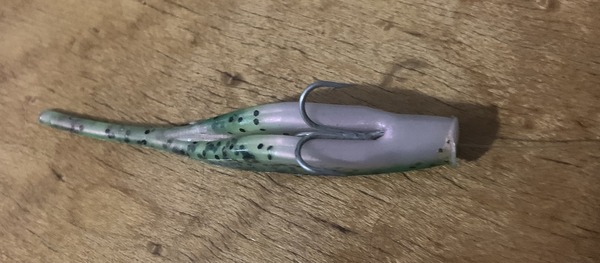
The second hook choice is actually my personal favorite. This is a treble hook, rigged like you would a line-through swimbait.
It takes one or two extra steps, but is well worth it when you are fishing open water.
First, you use a standard worm hook to get the line through the body of the fluke.
Just pretend you are rigging it Texas style, but bring the whole hook through the head of the bait.
Then take that hook off your line and tie it on to a treble hook.
Then slide the treble hook up into the fluke, with the eye poking in the head of the fluke and the top treble sticking into the body of the fluke.
This rigging method does a couple things. It increases your hook up ratio a bit and allows you to wake the fluke on spinning gear.
It also allows you to fish much smaller flukes that would be too small to rig up on a full sized worm hook.
Gear Setup
Your gear will depend on which hook you decide to rig the fluke on.
If you use a worm hook and rig the fluke Texas style, your going to need a baitcasting setup.
The bigger, single hook takes the extra strength of a baitcaster to set the hook properly.
But if you use the line-through treble hook, you can use spinning gear.
You line isn’t super important because you will be keeping your rod tip up out of the water, so it’s buoyancy and visibility aren’t very important.
I would stay away from monofilament, because it will be difficult to set the hook with the very stretchy mono.
Reeling this In
Waking a fluke is a technique that’s rapidly gaining popularity among bass anglers for its simplicity and effectiveness.
This method involves reeling a fluke-style soft plastic bait across the surface, creating a subtle, lifelike wake that mimics the natural movement of baitfish.
By choosing the right hook, starting the retrieve immediately, and maintaining a slow, steady pace, anglers can entice bass in clear, shallow waters.
Whether using a standard wide gap hook or a line-through treble hook, the key is to keep the fluke on the surface and moving naturally.
With these tips and techniques, waking a fluke can become a go-to strategy for successful bass fishing and your favorite way to fish a fluke for bass.

